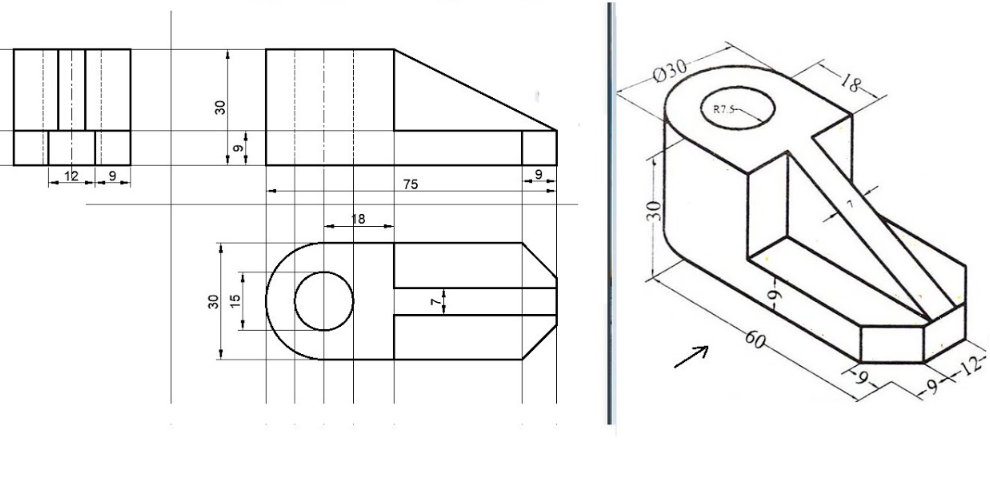Technical drawing is an indispensable part of design, design, and different producing processes, serving as an universal language that conveys exact specs and instructions. For professionals across these areas, the capability to translate and develop technical illustrations is extremely important to ensuring that tasks are finished properly and effectively. One of the foundational aspects of technical drawing is the use of different views-- each offering distinct insights into the dimensions, shape, and information of an object. The vital views in technical drawing consist of the front sight, leading sight, profile, section sight, isometric sight, and others, each playing a certain role in communicating important details to makers, engineers, and architects.
The front sight is typically the most well-known element of a technical drawing. The key goal of the front sight is to deliver a clear, simple representation of the item that stresses vital attributes, dimensions, and proportions.
Structure upon this, the leading view enhances the façade by supplying details regarding the deepness of the item. This sight permits designers to see exactly how vast and deep the object is, getting rid of obscurity that may occur from the preliminary façade alone. The top view assists to visualize connections in between various elements of the design, making it much easier to understand the design of parts, especially in complex systems with many overlapping components. When made use of efficiently, the leading sight can help interact essential aspects of performance and spatial setup that are important for producing and assembly.
The side sight, additionally recognized as the profile view, offers yet another perspective by depicting the object's height and deepness. By including the side sight right into the technical drawing, developers make sure that all measurements can be properly offered, developing a thorough sight of the things.
Discover technical drawing views the necessary function of technical drawing in design and design, highlighting essential views such as front, top, side, section, and isometric perspectives that ensure precise interaction and implementation in style and manufacturing.
Section views are an additional crucial element of technical drawings. They supply a method to depict the inner functions of a design that could not be noticeable from the outside views. A section sight is produced by slicing via the item and exposing its inner geometry.
One more valuable strategy in technical drawing is isometric forecast. This view supplies a three-dimensional representation of the object, giving a valuable illusion of deepness and range without requiring intricate point of view calculations. Isometric views can be unbelievably useful in conveying the total layout of an item, especially to people who might not be skilled in reading technical illustrations. While isometric projections fall brief of representing real perspective, they continue to be a prominent selection for providing concepts plainly and understandably. When responses and iterative renovation are important, this makes them specifically beneficial throughout the early layout stages.
In addition to these essential views, there are different other kinds of estimates, such as orthographic and perspective projections, that serve various features in technical drawing. Orthographic projections are a collection of several views that individually represent the object from different angles, usually in a two-dimensional format.

To effectively produce a technical drawing, it is important to understand the conventions and symbols that represent various attributes and measurements. Engineers and architects make use of various lines-- such as strong lines, rushed lines, and centerlines-- to share information about edges, functions, and crucial areas. Dimensioning is another crucial part of technical drawing. Correct dimensioning supplies essential measurements that dictate exactly how elements mesh, making certain that designs meet required tolerances and specs. Unreliable measurements can lead to costly mistakes during manufacturing, making this element of technical drawing crucial for reliability and success.
Numerous software program devices and applications assist in the technical drawing procedure, improving the conventional hand-drawing methods. Programs like AutoCAD, SolidWorks, and other Computer-Aided Design (CAD) software permit customers to produce complex 2D and 3D designs with far greater accuracy and adaptability than hands-on methods. These tools enable very easy alterations, permitting for fast prototyping and version without the need to recreate drawings from square one. This electronic change has significantly increased the layout and manufacturing processes across countless markets, driving development and enhancing efficiency.
In the context of markets today, understanding just how to apply various views in technical drawing is not only critical for designers and architects yet also for suppliers, product developers, and even marketing experts. In collective environments, especially in fields like building and manufacturing, clear technical illustrations make sure that all stakeholders-- from developers to clients-- are on the very same page.
In addition, with the increase of 3D printing and additive production, the significance of specific technical drawing ends up being also much more obvious. As these modern technologies continue to advance, they require in-depth specifications to make sure that physical models precisely personify the original style. The ability to from detailed technical illustrations, including several views, is essential for developing parts that not just mesh properly yet also operate successfully as part of wider systems. In addition, as industries shift to automatic and electronic processes, the skills required to produce and translate technical illustrations will be vital to future ability pipes.
In verdict, technical drawing incorporates numerous views, each of which plays a details duty in sharing needed info regarding an item. As innovation and techniques for developing technical illustrations continue to advancement, understanding and executing these views effectively stays vital. As we move even more into a period identified by quick technical development, the principles of technical drawing and its accompanying views will most certainly continue to be crucial in forming the future of layout, manufacturing, and engineering.
Comments on “How to Present Your Technical Drawings Effectively to Stakeholders”